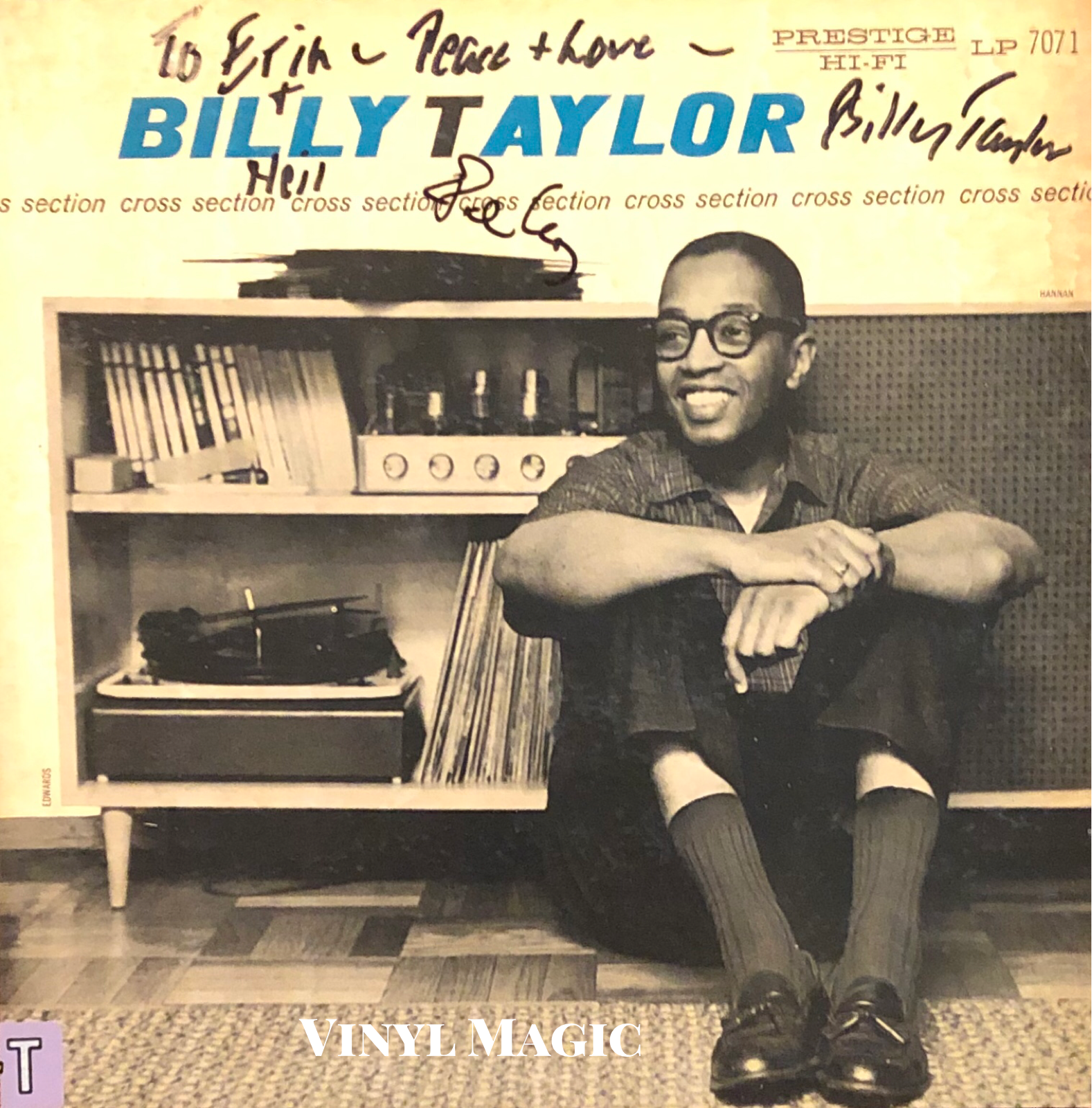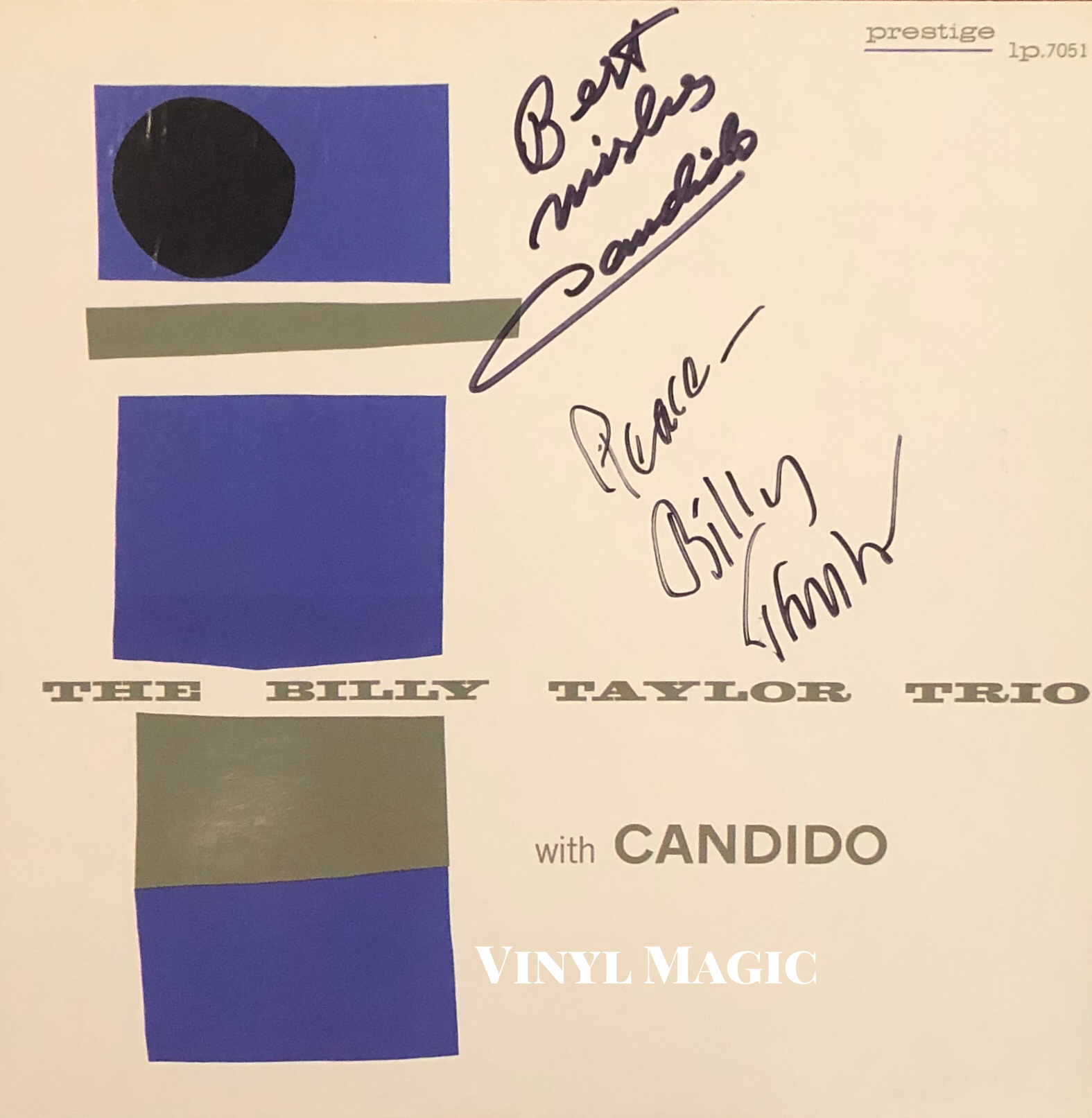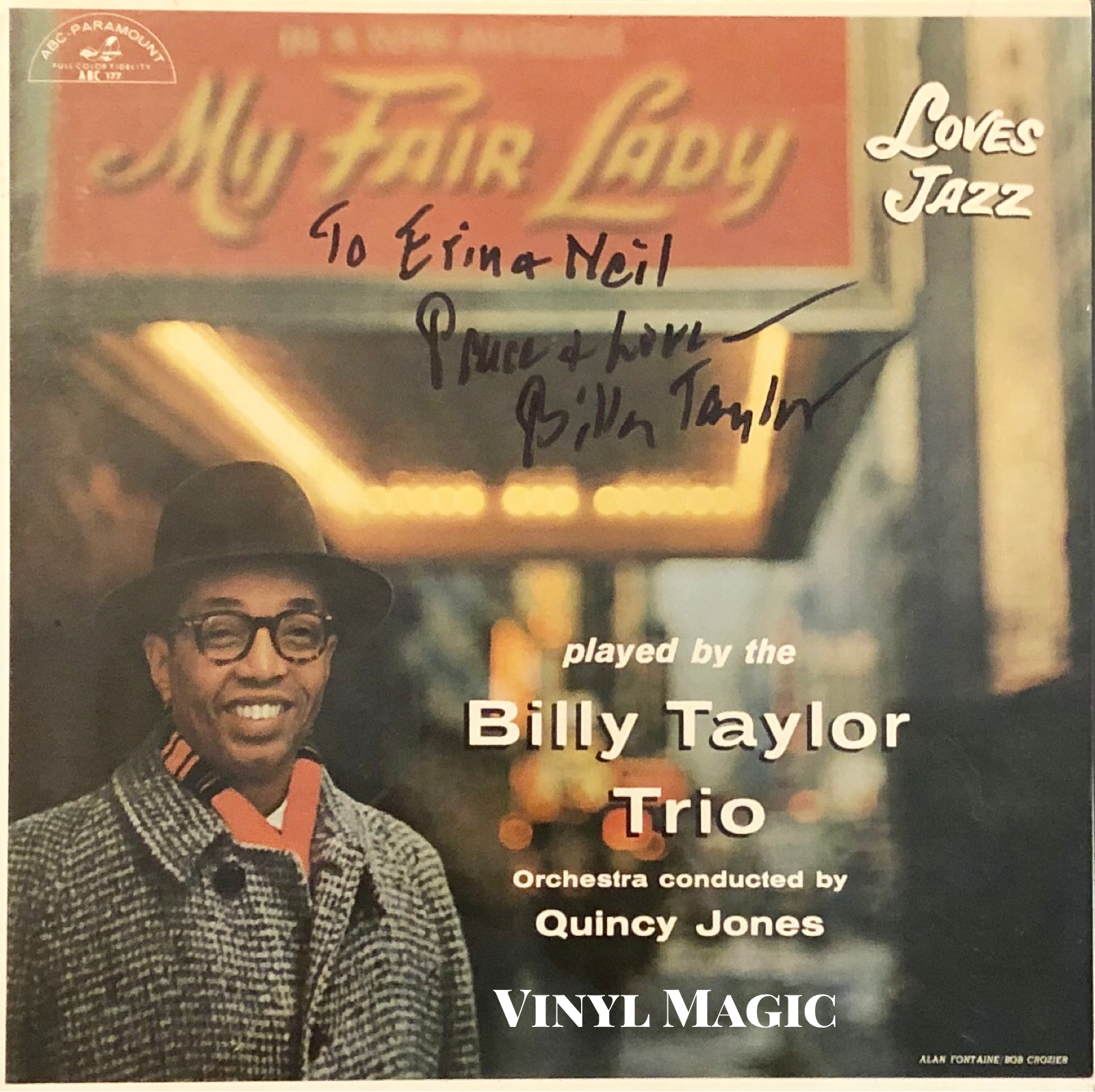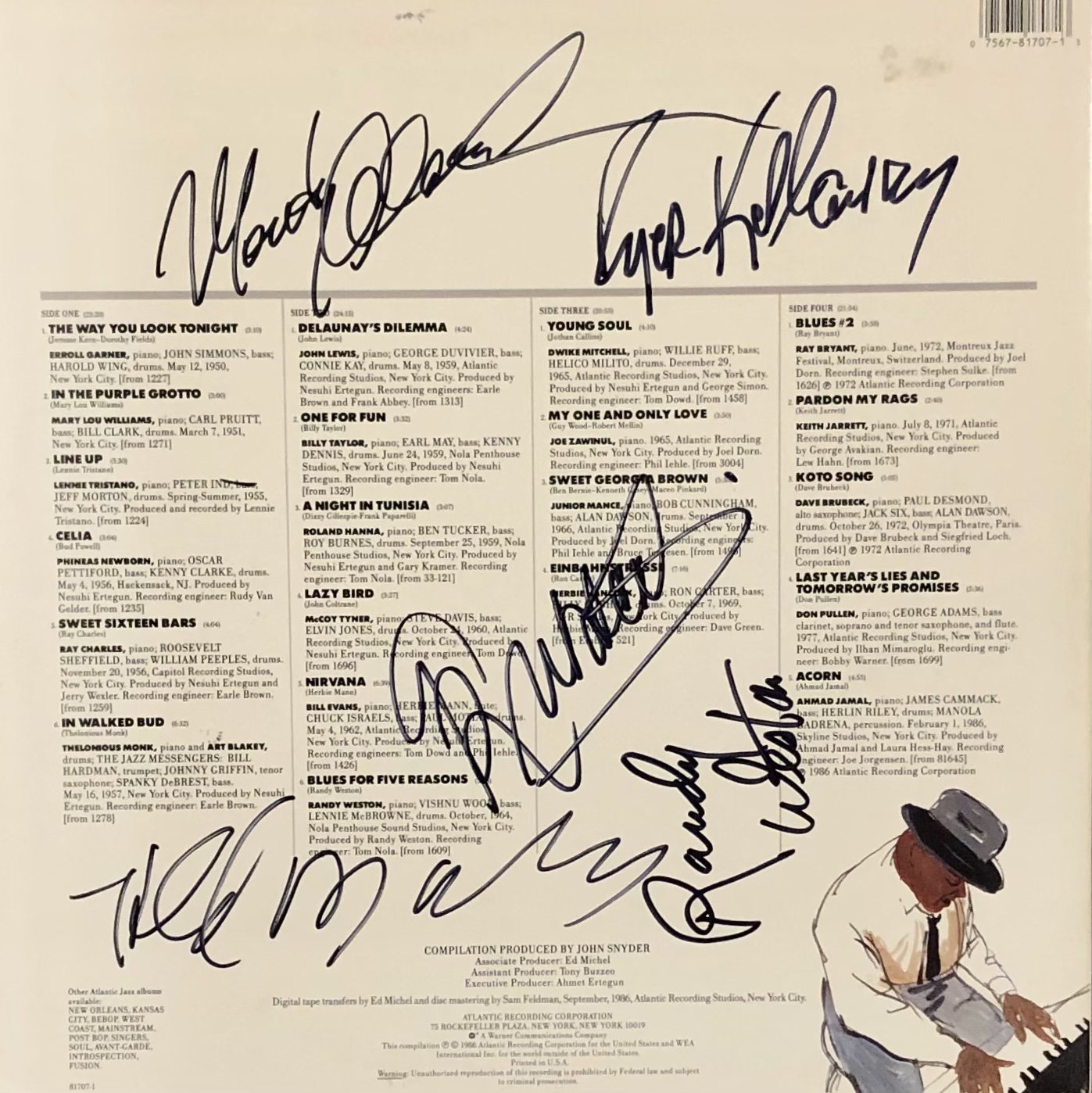Dr. Billy Taylor and Me…
When I was learning to play, I asked my Uncle Bob to teach me the way Art Tatum did. He said, "I'm self-taught, I can't do that. You'll have to teach yourself." But he gave me my first record: The Shout (1934) by Art Tatum. All I could think when I heard it for the first time was, 'Wow, who are those two guys?'
Billy Taylor
Coltrane was quiet. One of the things he talked to me about was Art Tatum. He wanted to know everything about him. He was very excited about Art's technique. "How does he do that?" Trane said, "It sounds like a glissando." I told him it was fingering and a glissando together, as one motion, and that Art was fingering that fast. Trane was pretty amazed.
Billy Taylor
Cross Section (1953-54 recordings, 1956 release) signed by Billy, Earl May
When I sit down at the piano, in my mind, I'm out to play elegantly and to swing. All of my mentors did this, playing the way they were thinking. The way you look and feel is the way you sound. I tried to live up to that...Friends used to come into Birdland and in between sets, they'd tell me they were bringing their girlfriends in the next night and asked if I could play some romantic ballads to help get things going!
Billy TaylorThere are many adjectives one could apply to Billy's playing - it is exciting, warm, and technically brilliant. He has a lot to say and he says it - from one end of the piano to the other - interpolating fugue-like variations into many of his uptempo tunes. He executes satin-smooth scale passages with equal facility in either hand (I'm jealous!) and a firm yet delicate touch. He has refined and even chiseled his style with loving care, like the excellent craftsman that he is, so that it resembles a finely cut diamond. It is polished, elegant, yet always contains the basic element essential in jazz - a good swinging feeling.
pianist Marian McPartland, The New Billy Taylor Trio liner notes (1957)
The Billy Taylor Trio With Candido (1954) signed by Billy, Candido
One day he came into Birdland to get some money from the boss. By then, I was the house pianist and was practicing my music lesson. I was studying with a wonderful teacher who was helping me with my classical playing. I would take a lesson and wouldn't go home because I'd be late for the gig if I did. So I went there and practiced my lesson before the club opened. Bird came in and heard me. He said, "That's nice, I like that." I said, 'It's Debussy.' He said, "I know that." I said, 'What do you mean you know that?' and laughed, turning back to play. I figured he was just putting me on. Well, Bird went to the back to get his money. When he came out, I was playing Debussy's "Arabesque #1" again. Bird took an alto horn off the bandstand and played the line I hadn't played yet. I was blown away.
Billy Taylor on meeting Charlie Parker
My Fair Lady Loves Jazz (1957) signed by Billy
If Billy Taylor did nothing else in his seventy years as a jazz pianist and composer, he wrote one of my favorite songs in 1963, "I Wish I Knew How It Would Feel To Be Free." Part rollicking soul groover, part gospel homily, it is an uplifting and moving song, reflective of the hardships and the struggles of the civil rights movement. It became a civil rights anthem. Billy recalled the song's humble origins, " My daughter Kim came home from school one day singing a spiritual. But she didn't really know what it was and didn't have the proper feel behind it. I said, 'Kim, this is part of your heritage. You can't be singing a spiritual like that, you have to have more feeling. I sat down at the piano and said, 'The spiritual is so much a part of our tradition that I can sit here and make one up on the spot. This is the feeling you need to have.' I made up a little ditty. Then I asked if she understood. She said, 'Yes, Daddy,' and went back to playing with her dolls. After she went back to her room, I got to thinking, 'Hey, this isn't a bad little tune.' So I wrote it down. Spirituals suggest things about who we are and what we're about and what we long for."
While the melody took a scant fifteen minutes to write, it took Billy eighteen months to complete the words, "I struggled with the lyrics. I called Dick Dallas, a young man I had been writing music with in those days. My words weren't saying what I wanted the song to say. Dick helped me finish the lyrics." Over the years, the song has been covered by Jazz artists Illinois Jacquet, Junior Mance, Shirley Scott, Soul artists Solomon Burke, Irma Thomas, Marlena Shaw, and neo-Soul artists John Legend and Emeli Sande. Even Levon Helm of The Bandsings a down home, dragged through the bayou, rock and roll rendition. Of course, the definitive reading (and Billy's favorite) remains the treatment by the incomparable Nina Simone in 1967. It doesn't get any better than the High Priestess of Soul testifyin'!
The New Billy Taylor Trio (1957) signed by Billy, Earl May, Ed Thigpen
Born in Greenville, North Carolina, raised in Washington, DC, Billy Taylor was a jazz pianist, educator, Emmy award winning broadcaster (well known as the on-air correspondent for CBS New Sunday Morning for more than twenty years), composer of more than three hundred songs, and the recipient of more than twenty honorary doctoral degrees, Billy also earned a doctorate while teaching at the University of Massachusetts in 1975. I have yet to meet a more genial, affable and erudite musician on or off stage than Dr. Billy Taylor!
Like many musicians, Billy's musical exposure started in the church where his father led the choir at the Florida Avenue Baptist Church in Washington, DC. By his own admission, he was not blessed with the singing talents of his father. Billy was more interested in the piano, so he decided to "sing through the piano." By luck (or providence!), he lived near Henry Grant, Duke Ellington's piano teacher. Billy remembered, "Once I decided I wanted to soak myself in good music, Henry Grant, my music teacher who lived across the street, encouraged me. Duke had studied with Mr. Grant. I remember taking lessons with him and the phone would ring. Mr. Grant would excuse himself for ten to twenty minutes. When he returned, he'd apologize and say it was Duke Ellington. Of course, I'd ask tons of questions. It was an amazing feeling to be taught by the same guy who had taught Duke!'
One For Fun (1959) signed by Billy, Earl May
After graduating from Virginia State College with a music degree in 1942, Billy returned home to hone his skills in Washington, DC before moving to New York City in 1944. His first day in New York, he met tenor saxophone great Ben Webster at Minton's, a famed Harlem jazz club on West 118th Street, renowned for its cutting sessions and late night duels. Later that night, Billy met the redoubtable Art Tatum, and they struck up a friendship as Art mentored Billy throughout his early years. Billy recalled, "Art Tatum just took to me. Every opportunity I got, I followed him around. He was legally blind, but he didn’t like people to make a big deal out of helping him, so I’d help him get a cab as if I were getting a cab for myself and then get into the cab with him. We’d go to after-hours places or wherever he wanted to go. Sometimes I’d ask, ‘How do you do that, Art?’ and he’d show me, but most of the time, if I hung around him enough, he’d play everything I wanted to know.” For a recent college graduate, it was an auspicious first night in New York City, and by the third day, Billy was invited to join Ben Webster's band. How the music gods smiled as the trajectory of Billy Taylor's career was ignited.
Billy spent the next sixty-five years performing, writing and, most of all, proselytizing the wonders of jazz. He was a tireless and indefatigable ambassador. In addition to his time in academia, Billy co-founded the Jazzmobile in 1964, an attempt to bring music to the masses, free and outdoors, away from smoky nightclubs and pricey, ornate concert halls. The first Jazzmobile was little more than a flatbed truck with beboppers blowing wildly as they drove through Harlem. It helped that John Coltrane, Dizzy Gillespie, Jimmy Heath, and Horace Silver were early participants. More than fifty years later with over four million visitors, Jazzmobile lives on and it has fulfilled Billy Taylor's mission. Eight free concerts were held this summer at Grant's Tomb, a National Memorial Park on Riverside Drive in New York City, a fitting testament to the power of music and the legacy of Dr. Billy Taylor.
Right Here, Right Now! (1963) signed by Billy
In 1994, Billy became the Artistic Director at The Kennedy Center and hosted Billy Taylor's Jazz at the Kennedy Center, an informal interview and jam session with jazz legends Donald Byrd, Kenny Burrell, Harry "Sweets" Edison, Joe Williams and many others. The format was simple: Billy and a distinguished guest would talk about their careers, influences, and music, and then each artist would perform with Billy's trio, usually bassist Chip Jackson and drummer Steve Johns. Each show was then edited for later broadcast on NPR. Erin and I were lucky to attend these shows which were held in the Theater Lab of the Kennedy Center. In those days, The Theater Lab was a bit of a ramshackle venue, maybe one hundred folding chairs strewn about a plywood platform stage. It has since been refurbished into a posh, nearly four-hundred seat auditorium.
Where’ve You Been? (1981) signed by Billy
The access to backstage was merely the slight push aside of a dark, heavy curtain, and there we were, hanging with Dr. Taylor and friends. Billy was as warm and gracious offstage as on, and his intelligence and wit was infectious. He laughed when he saw one of his first albums, Cross Section, "Look how young I am, and stylish! Those pants look awfully short." He loved the cover of The New Billy Taylor Trio. His colleagues, bassist Earl May and drummer Ed Thigpen, recline on a Mies Van Der Rohe day bed while lighting cigarettes. "I told them not to smoke," Billy wisely counseled, a non-smoker and teetotaler throughout his life. He loved the Atlantic Jazz Piano cover, "These are some of my favorite pianists," he said, as he looked at the names already inscribed: Dave Brubeck, McCoy Tyner, and Barry Harris. Erin and I thanked him for his kindness, generosity and artistry.
Atlantic Jazz Piano (1986) signed by Billy, Dave Brubeck, Ray Bryant, Kenny Barron, Sir Roland Hanna, Barry Harris, Tommy Flanagan, Hank Jones, Junior Mance, Andre Previn, Dwike Mitchell, Horace Silver, McCoy Tyner
Dr. Billy Taylor spent so much time as a broadcaster, educator and fundraiser that people forget how powerful a jazz pianist he is, with his formidable and enduring chops. Not many can claim a direct line from Duke Ellington to Art Tatum, and his influence informs and sustains many. As Ramsey Lewis told me at a show recently, "Billy Taylor is a great and underrated jazz pianist!" High praise indeed.
Dr. Billy Taylor, a life so well lived. Jazz, joy, love and service so inherently entwined.
Atlantic Jazz Piano (1986) back cover signed by Monty Alexander, Harold Mabern, Randy Weston, Roger Kellaway, Gonzalo Rubalcaba
Choice Billy Taylor Cuts (per BK's request)
https://www.youtube.com/watch?v=brBtTluod_w
“I Wish I Knew How It Would Feel To Be Free" Live with Billy Taylor Trio
https://www.youtube.com/watch?v=JeXtfmAwvvY
”I Wish I Knew How It Would Feel To Be Free" Nina Simone 1967
https:://www.youtube.com/watch?v=YtKBCil6qTk
”Mambo Inn" Live with Candido
https://www.youtube.com/watch?v=6LBkZRqMIG0
Ben Webster and Billy Taylor Live
https://www.youtube.com/watch?v=hRJUGnUq9io
”Goodbye" Cross Section 1954
https://www.youtube.com/watch?v=0O7Yg0NDqwE
"Summertime" One For Fun 1959
https://www.youtube.com/watch?v=MTkzT1UmaT0
"Caravan" Live with Chip Jackson, bass Winard Harper, drums 2000
https://www.youtube.com/watch?v=0bbvNAzS5rU
"I Wish I Knew How It Would Feel To Be Free" Billy Taylor meets Les McCann!
https://www.youtube.com/watch?v=WjlxOv2ljhI
"I Wish I Knew How It Would Feel To Be Free" Junior Mance 1994
https://www.youtube.com/watch?v=ltHAw3QZEDE
"Take The 'A' Train" live with Dave Brubeck
Bonus cuts:
https://www.youtube.com/watch?v=yeJo8MAqcdY
Art Tatum plays "The Shout"
https://www.youtube.com/watch?v=st0ICUPYPAY
"I Wish I Knew How It Would Feel To Be Free" Electric Dirt Levon Helm 2012








